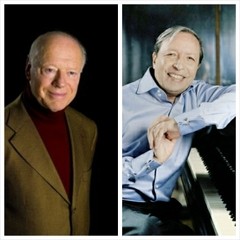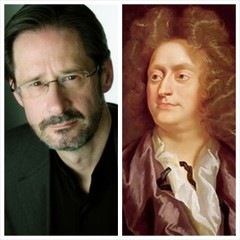|
Back
The Sculpture of a Concerto New York
Isaac Stern Auditorium, Carnegie Hall
02/11/2014 -
Steven Stucky: Funeral Music for Queen Mary (after Henry Purcell)
Robert Schumann: Piano Concerto in A Minor, Opus 54
Johannes Brahms: Symphony No. 4 in E Minor, Opus 98
Murray Perahia (Piano)
Boston Symphony Orchestra, Bernard Haitink (Conductor)

B. Haitink/M. Perahia (© Clive Barda/Courtesy of the Artist)
No expert on the attributes of Heaven, I might offer a thesis that the Life Hereafter should consist in listening to Radu Lupu, Garrick Ohlsson and Murray Perahia, all within little more than a week. On a more earthly aspect, their very differences, show the piano as a diamond, each facet glittering in a different way.
Ohlsson is more outward, less secret, his recital last week an exercise in the sheer pleasure of Beethoven and Chopin. Radu Lupu eschewed his supposed austere persona, offering a Bartók concerto of almost Mozartean elegance.
With Mr. Perahia, we have a pianist whose integrity to music precludes an idiosyncratic interpretation. But with such unassailable technique, with the most exquisite tone in the business, he can have an effect as rare as his appearances in New York.
When Murray Perahia performed the Schumann Concerto, only a Philistine would call it a “warhorse”. The Concerto last night, though, was not a live horse at all. It was like a Michelangelo sculpture of a horse. Perfectly carved, looking as if it would bound out from the stable, ready to prance and run.
But still, a sculpture, something to respect even in its coldness. I could still revel in that wonderful Perahia tone, his first-movement cadenza was exciting, but the Intermezzo was produced so elegantly that one forgot the human behind it. The utter beauty of transition between second and third movements led to a finale running at full speed, but without joy. It was not done by rote, yet something was missing.
The reason why this Concerto has been so popular is that moods change with each measure, the Schumann latent madness and almost neurotic adoration of his wife (for whom it was written) offer a universe of feelings, few of which we caught here.
After all, this is no “perfect” concerto. It dreams, it jokes, it rhapsodizes, it even waltzes... Mr. Perahia is always worthy of respect, Mr. Haitink can be a great conductor, the Boston Symphony First Chair players are the best. But last night, they simply played a superb piece of music very well, even faultlessly. Which didn’t necessarily make for a great performance.
Mr. Haitink ended with another piece of utter (if never over-) familiarity, Johannes Brahms’ final symphony, and he did whip the Boston Symphony into shape by the final movement. Before this, it was a clean, forceful, rigorous performance, the sort of music for which Haitink and his orchestra could play on automatic pilot.
Of course they didn’t, but few moments stood out. The flute solo in the Andante moderato was ravishing, the trombones in the final passacaglia were modestly sinewy. I read where Brahms, while composing this, predicted that “a catastrophe is coming.” Mr. Haitink didn’t offer either tragedy or catastrophe. He gave an estimable frequently majestic performance, worthy of his orchestra and his composer.

S. Stucky/H. Purcell (© Hoebermann Studios/Public domain)
Outside of hearing Mr. Perahia, I was curious to hear what the always surprising Steven Stucky had in mind for arranging (or transposing or re-orchestrating) Henry Purcell’s Funeral Music for Queen Mary. The original, written for the monarch who died in 1694 of smallpox, is already celebrated for its great brass ensembles, its pounding drumbeats, and a beautifully poetic poem set to equally beautiful music.
The result was not terribly impressive. Esa-Pekka Salonen had commissioned it for the Los Angeles Symphony Orchestra, but Mr. Stucky had left out the strings and arranged a work resembling the original. At times, it was like the Stokowski orchestrations of Baroque music, at times, it was Stucky with his brilliant sense of orchestral timbre.
True, a series of loud harp twangs took the place of the original bass drum, but the drummer had his revenge with a series of fffff drum beats at the finale. True, Mr. Stucky added a bass pedal note throughout most of the eight minutes, true, he augmented the music with a beautiful resonance of piano, glockenspiel, tubular bells and xylophone.
But his main contribution was to use the same music, but updated a few centuries with moments of dissonance and rhythmic alterations, just as Luciano Berio did with his Schubert fragments. That, though, was successful, since Berio had the impetus to finish yet another a second Schubert “unfinished” symphony. Mr. Stucky had an already finished work, already grand in forces and funereal intent. Gilding this lily produced glitter, radiant hues, but more gilt than gold.
Harry Rolnick
|